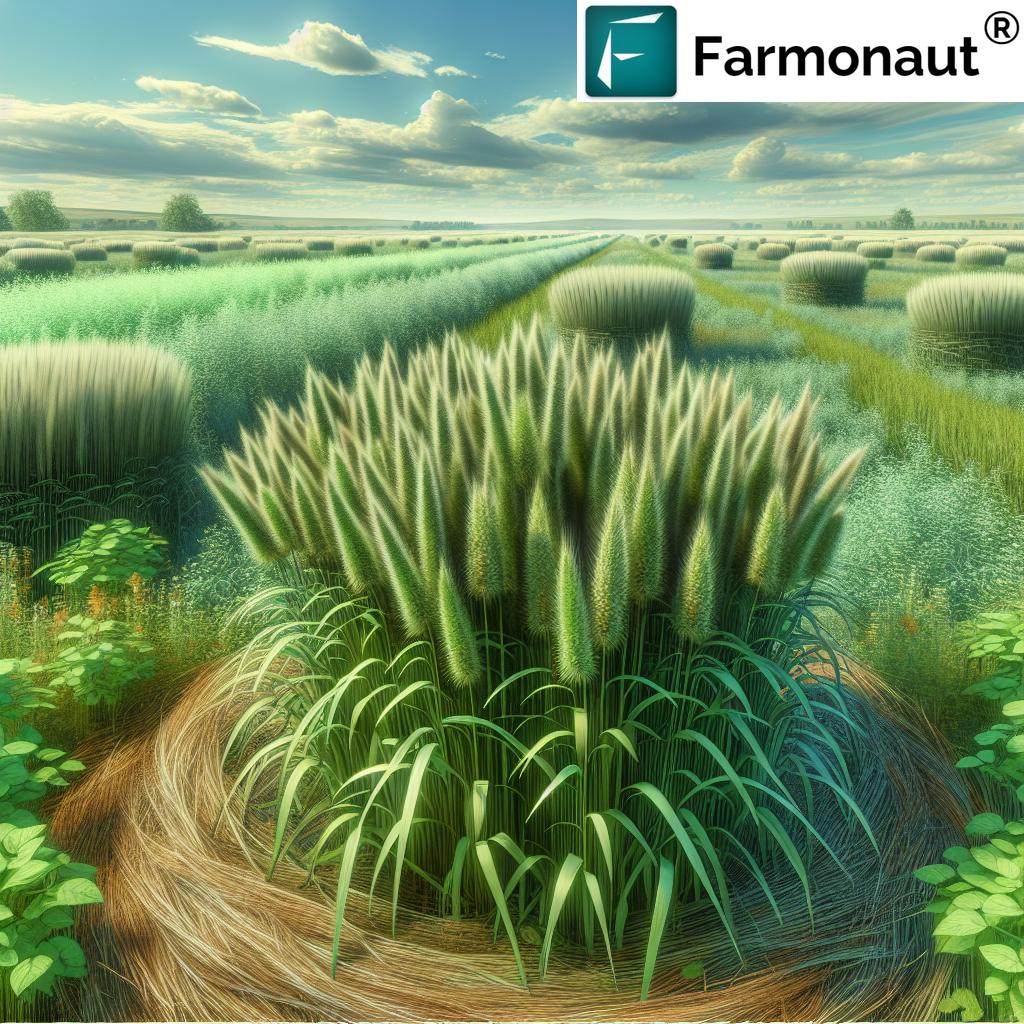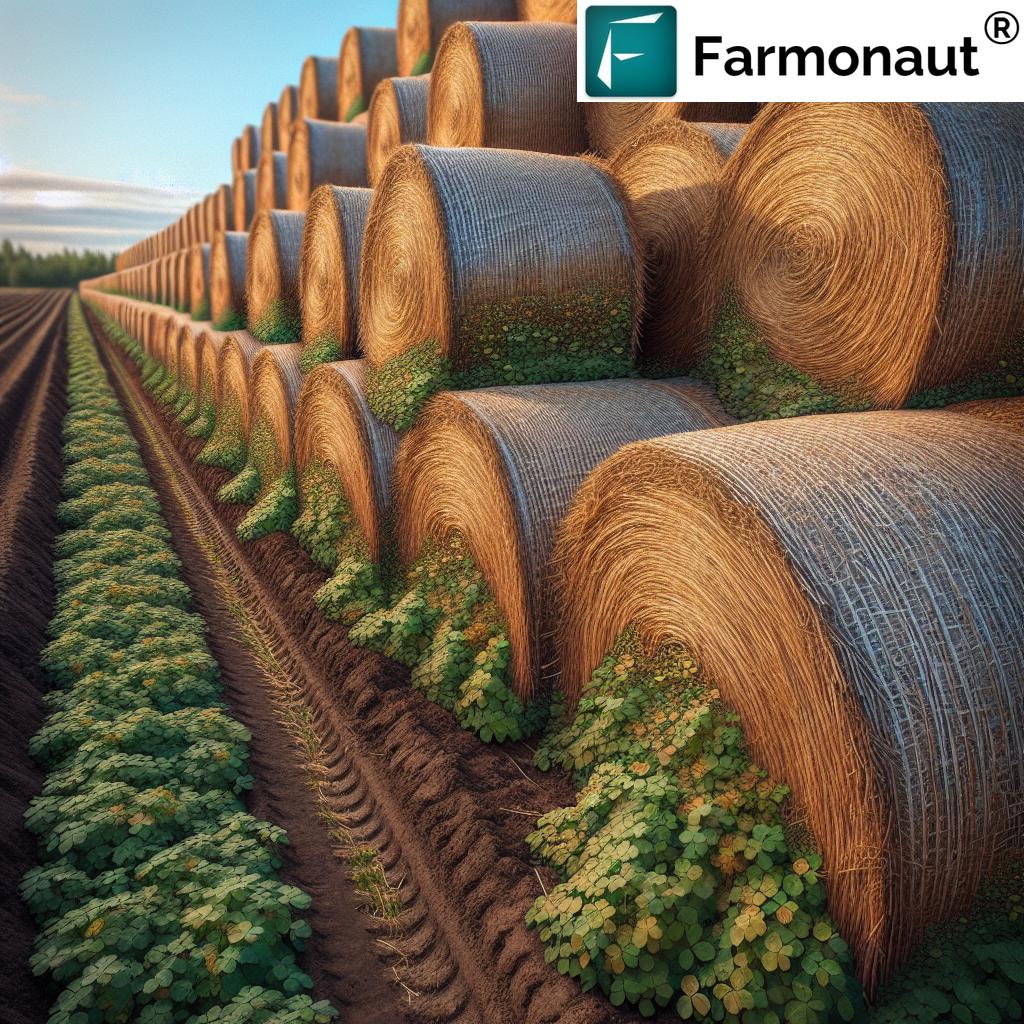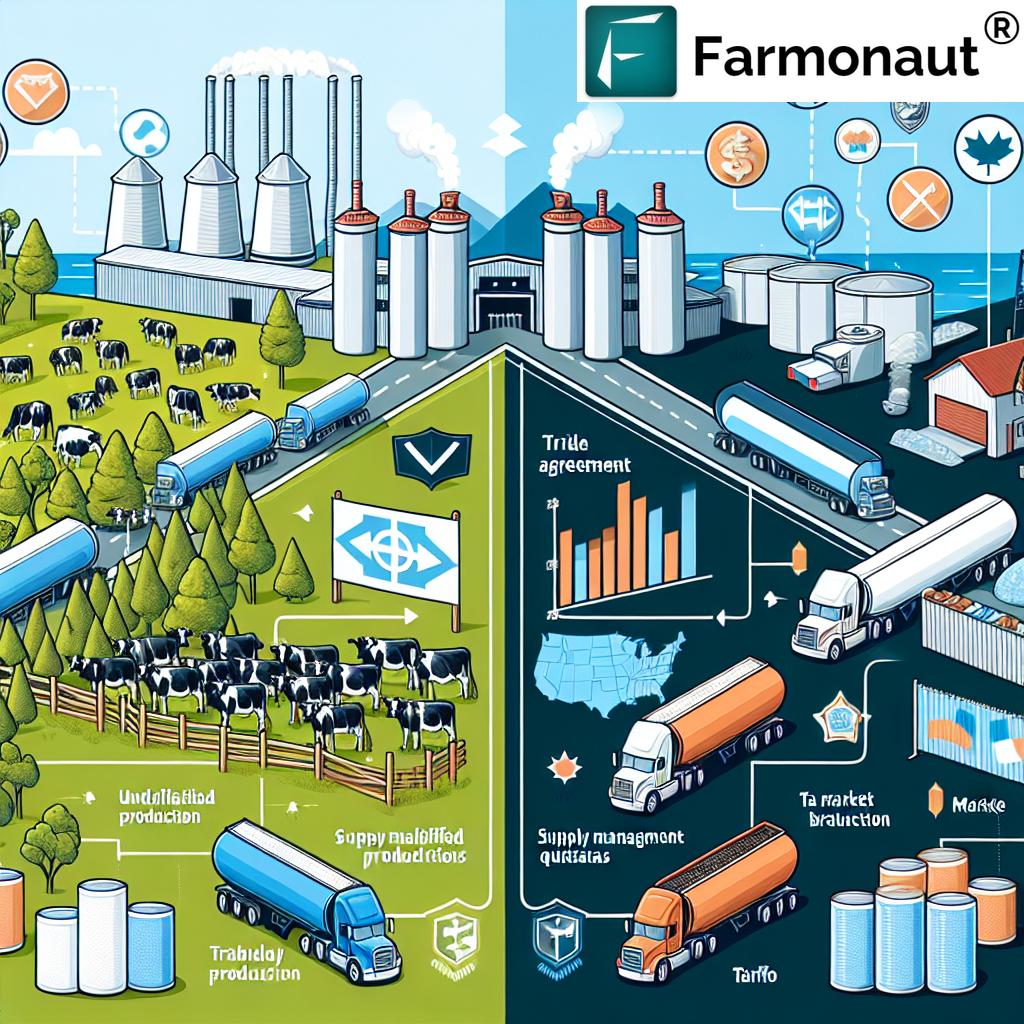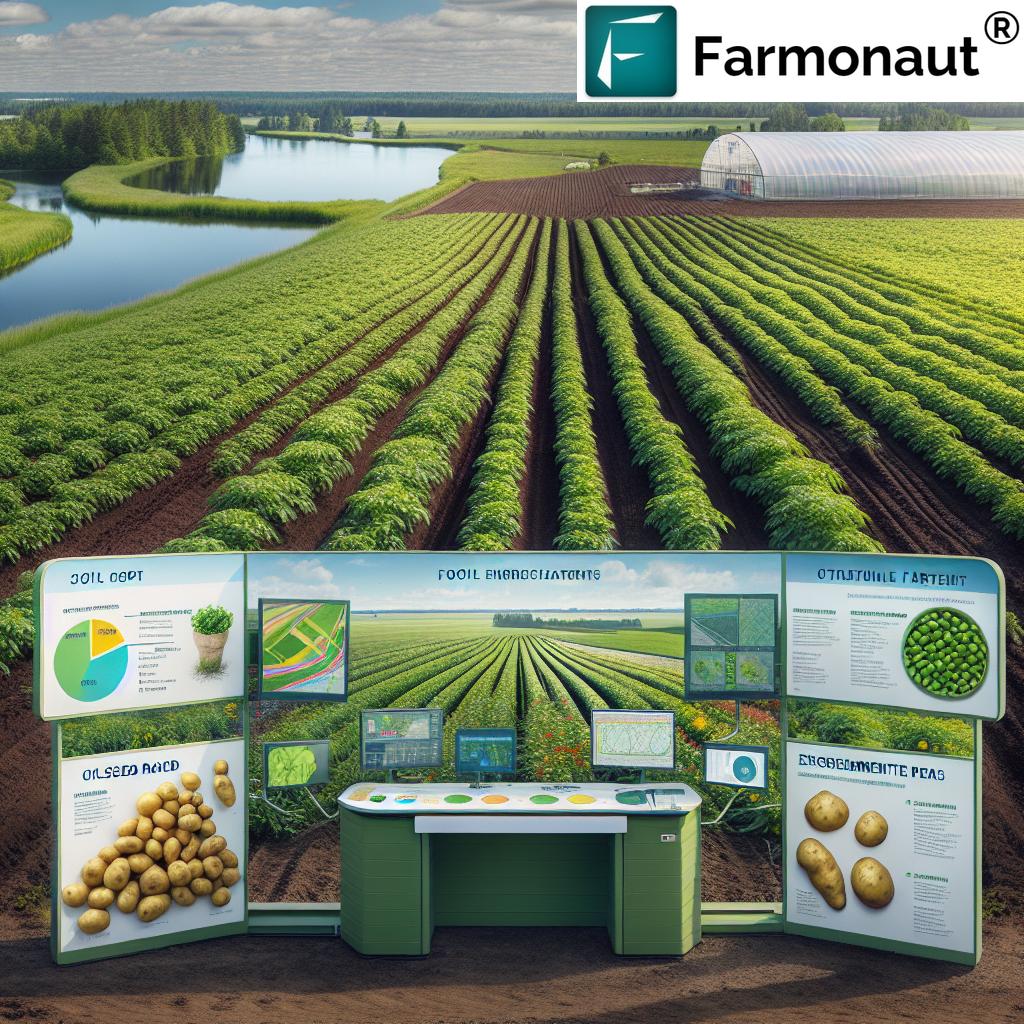Timothy Hay: 7 Secrets for Huge Yields in Canada
Introduction to Timothy Hay
Timothy hay—derived from the hardy, perennial Phleum pratense—is widely regarded as a staple forage crop due to its high fiber content, exceptional palatability, and sustained value in livestock nutrition. While native to Europe, it is now prominent in North American agriculture, particularly in Canada’s cooler, moist regions like Manitoba.
In this comprehensive guide, we’ll unveil the seven secrets to maximizing yields, boosting forage quality, and enhancing the environmental sustainability of timothy hay cultivation. We’ll also explore how advanced solutions, like those from Farmonaut, are revolutionizing sustainable management practices for Canadian growers.
Secret 1: Mastering Timothy Grass Botanical Characteristics
To achieve huge yields in Canada, we first need a thorough understanding of timothy grass’s botanical characteristics. Recognizing these core features helps optimize every aspect of timothy grass cultivation—from selecting robust varieties to identifying the optimal growth stage for harvesting.
What Makes Timothy Grass Ideal for Canadian Climates?
- Slender, Erect Stems – Timothy grass (Phleum pratense) is characterized by slender, upward-growing stems that can reach up to 1.5 meters.
- Narrow Leaves & Cylindrical Seed Head – Its narrow leaves support high-fiber photosynthesis, and its signature seed head is cylindrical, forming a spike-like inflorescence.
- Hulls & Seeds – Each seed is encased in a protective hull, providing resilience during cold winters and mechanical stress.
- Perennial Growth Habit – As a perennial, timothy grass regrows year after year, reducing replanting effort and costs.
- Winter Hardiness – Its natural tolerance to cold and moist climates explains why growing timothy hay in Canada (especially Manitoba) is so successful.
These attributes form the biological backbone for high-yield, sustainable timothy hay production in Canadian agriculture.
Secret 2: Selecting the Best Soil for Timothy Grass
The foundation of bumper yields lies in careful soil selection and management. Timothy hay thrives in well-drained, fertile soils, preferring a pH between 5 and 7. Let’s review why this matters, and how you can optimize your field for timothy grass cultivation.
Ideal Soil Characteristics for Timothy Hay
- Well-Drained Soils: Water-logged soils can cause root rot and lower yields; timothy grass roots require oxygen.
- Soil Texture: Silty loams and loams are preferred due to their moisture retention and aeration balance.
- Soil pH (5.0-7.0): This range supports nutrient uptake and robust microbial activity, crucial for nutritional value.
- Moderate Fertility: Although timothy is not extremely demanding, sustainable fertilization ensures continuous high yields.
Before seeding, we recommend conducting detailed soil assessments. Farmonaut’s Carbon Footprinting Solution offers real-time soil carbon and moisture analysis, supporting precision agriculture and promoting sustainable practices.
Secret 3: Precision Seeding and Stand Establishment
The establishment phase sets the stage for healthy, high-yielding timothy hay stands. Careful planning and execution are key—as is ongoing weed control and seedbed prep.
Key Steps for Seedbed Preparation and Seeding
- Site Selection & Preparation: Select a field with uniform fertility and minimal weed pressure. Use a stale seedbed approach to reduce competitive weeds prior to seeding.
-
Seeding Rates & Techniques:
- For pure timothy hay production, use around 8 pounds of seed per acre (~9 kg/ha)—enough for wide tillering yet not excessive crowding.
- When timothy is interseeded with legumes (like alfalfa), adjust rates accordingly—often slightly lower (4–6 lbs/acre timothy, 8–10 lbs/acre alfalfa) to promote coexistence.
- Optimal Seeding Depth: Aim for 0.25 to 0.5 inches (6–13 mm)—shallow seeding enhances uniform emergence.
- Timing for Planting: Early spring or late summer (if moisture is available) produces best results in Canadian climates.
Precision seeding, facilitated by Farmonaut’s Satellite Data API, ensures reliable stand establishment—an essential consideration in timothy hay production practices.
For developers or enterprises seeking to integrate advanced remote sensing for crop monitoring or seeding optimization, check out our Satellite & Weather API Documentation for seamless implementation.
Secret 4: Sustainable Timothy Hay Production Practices
Long-term sustainability and consistent high yields depend on a balanced approach to fertilization, irrigation, crop rotation, and resource management. Let’s review the most effective timothy hay production practices for Canadian fields.
1. Controlled Irrigation
- Although timothy hay is drought sensitive, over-irrigation causes root disease. Adopt a schedule that supports summer growth but allows moderate drying between applications.
- Monitor soil moisture using precision tools, such as Farmonaut’s satellite-based monitoring, to avoid both under- and over-watering.
2. Sustainable Fertilization (Nutrient Management)
- Soil testing guides the application of N-P-K fertilizers. Avoid high rates of nitrogen near harvest to preserve forage quality.
- Integrate organic amendments (e.g., compost) to foster soil health and microbial diversity.
3. Crop Rotation
- Rotate timothy hay with annual crops or other grasses/legumes to break pest and disease cycles while replenishing soil nutrients.
- Crop rotation promotes deeper carbon sequestration and enhances timothy grass environmental benefits.
4. Integrated Pest & Weed Management
- Prioritize non-chemical weed control (mowing, tillage, crop selection).
- Use precision agriculture data to target pest infestation only when economically justified—reduces input costs and preserves beneficial organisms.
Leveraging insights from Farmonaut’s Large-Scale Farm Management Suite can streamline these best practices with real-time crop health monitoring, AI-based advisories, and efficient input management.
Secret 5: Perfect Harvesting Timing & Quality Considerations
High-quality forage depends on timely harvesting and efficient post-cutting management. Timothy hay harvesting time plays a vital role in nutritional value, market acceptance, and overall yield.
Timothy Hay Harvesting Time: When Is It Optimal?
- The best time to cut is at early flowering stage—just before seed head “velvet” sheath opens completely (“boot” to early bloom).
- Harvesting too late results in lower digestibility and protein, while cutting too early reduces yield.
- In cooler Manitoba summers, watch crop-soil interactions closely—Farmonaut’s real-time advisories can help pinpoint perfect maturity windows.
To produce premium-grade timothy hay:
- Cut at the correct stage.
- Dry quickly and evenly to avoid mold (hay moisture should be 12–15% before baling for export).
- Use gentle raking to preserve tender leaves—the major source of digestible fiber and nutrients.
Export-targeted timothy hay from Canada is especially scrutinized for green color, leafiness, and lack of foreign matter. These quality considerations attract top-tier international buyers.
Secret 6: Maximizing Timothy Hay Nutritional Value
A major reason timothy hay is valued across Canada and North America is its exceptional nutritional profile. By optimizing crop management practices, we boost the nutritional value for all herbivorous animals.
Key Nutritional Components
- High Fiber Content (NDF/ADF): Supports healthy digestion in horses, cattle, rabbits, guinea pigs, and chinchillas.
- Moderate Crude Protein (7–11% at Early Bloom): Sufficient for adult maintenance; can be adjusted via mixed seeding with alfalfa for higher protein demands.
- Low Calcium & Moderate Energy: Important for routine feeding of timothy hay for rabbits (excess calcium is avoided in small animals).
- Excellent Palatability: Ensures animals readily consume hay, minimizing waste.
The highest timothy hay nutritional value is achieved through:
- Timely cutting
- Rapid field drying
- Proper post-harvest storage and handling
For producers, understanding crop health patterns directly influences nutrition and digestibility. Farmonaut’s Crop Plantation & Advisory Tools use AI-driven insights to forecast nutrient status and ideal intervention points.
Secret 7: Environmental & Economic Benefits of Timothy Hay in Canada
Beyond yield and feeding value, timothy grass cultivation offers significant environmental stewardship and economic value to Canadian agriculture.
Environmental Benefits
- Soil Conservation: Dense, perennial stands (Phleum pratense) significantly reduce soil erosion, especially on rolling Canadian prairies (up to 30%).
- Carbon Sequestration: Long-lasting root systems capture and store carbon, enhancing soil organic matter.
- Biodiversity: Timothy meadows support pollinators and beneficial insects.
- Reduced Inputs: Once established, stands require less tillage and can be integrated into low-input or organic agriculture systems.
For businesses tracking environmental compliance or striving for eco-certifications, Farmonaut’s Carbon Footprinting Platform quantifies emissions and demonstrates sustainability.
Economic Impact
- Export Revenues: Manitoba leads as a primary export hub—Canadian timothy hay is highly sought in Asia and the US for its clean, green appearance.
- Premium Pricing: Highest quality bales command top prices when nutritional and visual standards are met.
- Stable Demand: Used as a staple forage across cattle, dairy, equine, and small animal markets.
- Lower Risk Profile: Perennial nature and cold adaptation reduce reseeding risk, stabilizing income streams for growers.
To tap into finance or insurance for your timothy operation, explore Farmonaut’s Crop Loan & Insurance Verification Platform, which uses satellite-based monitoring to streamline and secure agricultural lending.
Empowering Sustainable Timothy Hay Cultivation with Farmonaut
To remain competitive and sustainable, Canadian timothy hay producers leverage advanced agricultural technology. Farmonaut seamlessly brings together satellite imaging, AI advisory, blockchain-based traceability, and carbon tracking—providing crucial decision support from field to market.
Why Use Farmonaut for Timothy Hay?
- Real-Time Crop Health Monitoring: Multispectral imagery helps detect vegetation stress early, enabling proactive management.
- AI-Based Advisory: Get custom recommendations for seeding, fertilization, irrigation, and harvesting to optimize yields.
-
Traceability for Export: Blockchain-based records ensure secure, transparent history—essential for export markets prioritizing food safety and sustainability.
Explore Farmonaut Traceability Solution -
Resource & Fleet Management: Simplifies logistics and reduces operational costs by optimizing use of agricultural machinery and fleets.
More About Farmonaut Fleet Management - Scalable Platform: Whether you manage 100 or 10,000 acres, Farmonaut adapts to your operation size.
Use Farmonaut’s app on Android, iOS, or Web to access these solutions from anywhere—empowering precision agriculture and sustainable timothy hay farming in Canada.
Timothy Hay Cultivation Best Practices & Outcomes
| Cultivation Practice | Estimated Yield Increase (%) | Nutritional Impact | Environmental Benefit |
|---|---|---|---|
| Crop Rotation | 10–15% | Boosts crude protein by 1–2%, slightly increases fiber quality | Improved soil health, higher organic carbon retention |
| Optimal Seeding Rate (Pure Stand, 8 lbs/acre) | 5–8% | Denser stands yield more digestible fiber | Efficient land use, minimizes weed competition |
| Controlled Irrigation | 10–18% | Maintains protein levels, prevents water stress | Conserves water, protects roots from disease |
| Sustainable Fertilization (Soil Tested N-P-K, Compost) | 8–12% | Nutrient content stays optimal, fiber remains high | Reduces runoff, improves microbial life |
| Timely Harvest (Early Bloom) | 15–20% | Maximal digestible fiber, crude protein ~9–11% | Minimizes plant waste, reduces environmental spoilage |
Frequently Asked Questions (FAQ)
What is timothy hay and why is it important in Canadian agriculture?
Timothy hay is harvested from Phleum pratense, a perennial grass native to Europe but now a core crop in Canada. Its high fiber content, palatability, and robust adaptation to cool, moist climates make it an essential forage for cattle, horses, and small herbivores. It also supports agricultural sustainability through soil conservation and carbon sequestration.
How do I choose the best soil and field for timothy hay production?
Select well-drained, moderately fertile soils—preferably silty or loam—with a pH of 5.0–7.0. Avoid low-lying patches prone to waterlogging, and prepare your seedbed to reduce weed pressure before sowing.
What is the best seeding rate and planting time for timothy grass in Manitoba, Canada?
A pure timothy stand should be seeded at approximately 8 pounds per acre. Early spring seeding is generally optimal in Manitoba’s climate, but late summer can work if soil moisture is adequate.
When should I harvest timothy hay for maximum nutritional value?
Harvest timothy hay at the early flowering stage (boot to early bloom), just as the seed head emerges from the sheath. This provides the best compromise between yield and digestibility, especially for export-quality hay.
What animals benefit most from timothy hay?
It is widely used for cattle (dairy/beef), horses, and small herbivorous animals such as rabbits, guinea pigs, and chinchillas. Its balance of fiber and moderate protein/calcum is particularly well-suited to timothy hay for rabbits and other small mammals.
How does Farmonaut support sustainable timothy hay cultivation?
Farmonaut provides satellite-based crop health monitoring, AI-driven farm advisory, carbon tracking, blockchain traceability, and resource management tools. These enable Canadian growers to optimize yields, comply with environmental goals, and gain market edge through data-driven, sustainable agriculture.
Where can I find more resources on farm management and climate-smart agriculture?
Download the Farmonaut app for Android, iOS, or Web via the links above, or explore our APIs for advanced agricultural integration and management options.
Conclusion: Cultivating Excellence with Timothy Hay in Canada
By strategically implementing these seven secrets to timothy hay production, Canadian farmers can achieve exceptional yields, market-leading quality, and sustainable stewardship.
From selecting optimal soils and managing precise seeding, to making data-empowered decisions on timothy grass cultivation and harvesting time, the future of Canadian forage production is bright.
As the demand for traceable, high-nutrition, and environmental-friendly forage rises worldwide, innovative technologies like Farmonaut are reshaping how we monitor, manage, and market Canadian timothy hay—ensuring profitability, animal health, and environmental sustainability for generations to come.
For enterprise resource planning or integration with business platforms, explore Farmonaut’s Satellite API for farm analytics, and read our developer documentation for deep customization options.


















